|
de Havilland Mosquito FB. Mk. VI

Tamiya, 1/32 scale
S
u m m a r y |
| Description and Catalogue Number: |
Tamiya Kit No. 60326 - de Havilland Mosquito FB Mk.VI |
| Scale: |
1/32 |
| Contents and Media: |
678 parts in grey injection-moulded plastic for the aircraft (incl. 38 parts not used); 25 parts in grey plastic for three crew figures; 42 parts in clear plastic (including 12 limited edition parts for the initial export release); two photo-etched frets (22 parts not used); one self-adhesive masking sheet; small screwdriver; various metal screws, nuts, shafts and magnets; two decal sheets with markings for three subjects. |
| Price: |
Japan RRP - ¥ 19,800 |
| Review Type: |
Test Shot Preview |
| Advantages: |
Perfectly moulded; accurate; excellent detail with two full engines, cockpit, and wheel wells; improved instrument panel design with the use of a photo-etched front panel; separate control surfaces; large number of useful options including alternative exhausts, propeller blades, spinners, wheel hubs and carburettor intakes; three excellent crew figures included. |
| Disadvantages: |
|
| Conclusion: |
Tamiya has raised the bar once again. This is an outstanding kit. If you have the slightest interest in the Mosquito, Tamiya’s new 1/32 scale kit will be an essential ornament to your modelling shelf. |
Reviewed by Brett Green

Airfix's 1/48 scale Spitfire Mk. Vb will be available online from Squadron.com
Background
The de Havilland DH.98 Mosquito was a British multi-role combat aircraft with a two-man crew that served during and after the Second World War. It was one of few operational front-line aircraft of the era constructed almost entirely of wood and was nicknamed "The Wooden Wonder".
The Mosquito was also known affectionately as the "Mossie" to its crews.
Originally conceived as an unarmed fast bomber, the Mosquito was adapted to roles including low to medium-altitude daytime tactical bomber, high-altitude night bomber, pathfinder, day or night fighter, fighter-bomber, intruder, maritime strike aircraft, and fast photo-reconnaissance aircraft. It was also used by the British Overseas Airways Corporation (BOAC) as a fast transport to carry small high-value cargoes to, and from, neutral countries, through enemy-controlled airspace.
A single passenger could be carried in the aircraft's bomb bay, which was adapted for the purpose.
When the Mosquito began production in 1941, it was one of the fastest operational aircraft in the world. Entering widespread service in 1942, the Mosquito was a high-speed, high-altitude photo-reconnaissance aircraft, continuing in this role throughout the war. From mid-1942 to mid-1943 Mosquito bombers flew high-speed, medium or low-altitude missions against factories, railways and other pinpoint targets in Germany and German-occupied Europe. From late 1943, Mosquito bombers were formed into the Light Night Strike Force and used as pathfinders for RAF Bomber Command's heavy-bomber raids. They were also used as "nuisance" bombers, often dropping Blockbuster bombs - 4,000 lb (1,812 kg) "cookies" - in high-altitude, high-speed raids that German night fighters were almost powerless to intercept.
As a night fighter, from mid-1942, the Mosquito intercepted Luftwaffe raids on the United Kingdom, notably defeating Operation Steinbock in 1944. Starting in July 1942, Mosquito night-fighter units raided Luftwaffe airfields. As part of 100 Group, it was a night fighter and intruder supporting RAF Bomber Command's heavy bombers and reduced bomber losses during 1944 and 1945.
As a fighter-bomber in the Second Tactical Air Force, the Mosquito took part in "special raids", such as the attack on Amiens Prison in early 1944, and in precision attacks against Gestapo or German intelligence and security forces. Second Tactical Air Force Mosquito supported the British Army during the 1944 Normandy Campaign. From 1943 Mosquito with RAF Coastal Command strike squadrons attacked Kriegsmarine U-boats (particularly in the 1943 Bay of Biscay, where significant numbers were sunk or damaged) and intercepting transport ship concentrations.
The Mosquito flew with the Royal Air Force (RAF) and other air forces in the European, Mediterranean and Italian theatres. The Mosquito was also operated by the RAF in the South East Asian theatre, and by the Royal Australian Air Force (RAAF) based in the Halmaheras and Borneo during the Pacific War. *
The Mosquito in 1/32 scale
Revell released their 1/32 scale bomber variant, the Mosquito Mk.IV, way back in the 1960s. This model suffered from some serious shape problems, although it is inexpensive and is still regularly re-released.
HK Models has just recently released their Mosquito Mk.IV, which is a vast improvement over the Revell kit in terms of detail, and also features some clever design elements.
Tamiya's Mosquito FB. Mk.VI is the first kit of this important fighter/bomber variant to be offered as mainstream 1/32 scale kit.
Please note that the sample under review is a series of test shots, so it may not represent the final kit in all respects. However, this sample is complete.
Tamiya’s 1/32 scale Mosquito Mk.VI comprises 678 parts in grey injection-moulded plastic for the aircraft (including 38 parts not used), 25 parts in grey plastic for three crew figures, 42 parts in clear plastic (including 12 limited edition parts for the initial export release), two photo-etched frets (22 parts not used), one self-adhesive masking sheet, small screwdriver, various metal screws, nuts, shafts and magnets, and two decal sheets with markings for three subjects.
Surface detail is as fine as we have come to expect from Tamiya's 1/32 scale releases. Being largely of wooden construction, surface features on the fuselage and wings are mostly hatches and access points. Metal areas such as the nacelles receive the usual gorgeous finely recessed panel lines and selective rivets - both recessed and raised. I think that the fabric detail on the tail control surfaces is Tamiya's best yet - very subtle.
The fuselage halves are each presented in four main parts. The separate forward halves strongly suggest that we will see different variants in the future.
Cockpit detail is excellent straight from the box. The forward fuselage interior features a large number of raised circles. Please note that these are actual features of the Mosquito - they are not ejector circles or moulding artefacts, so don't remove them!
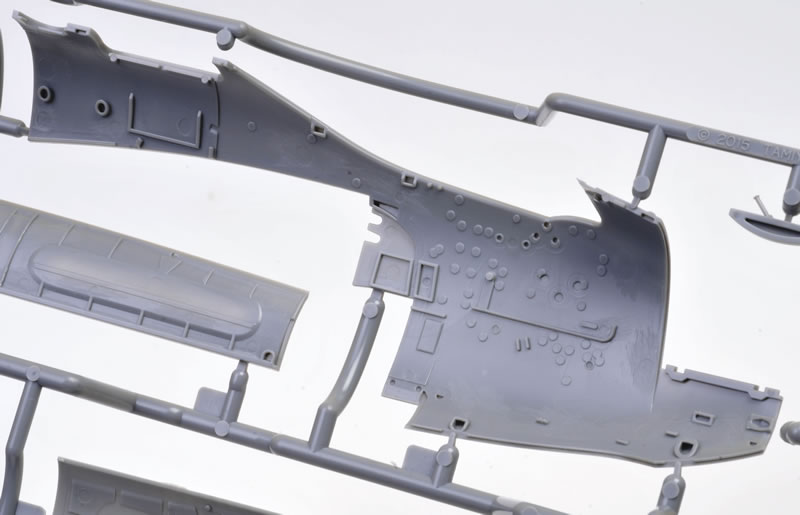
The very detailed pilot's seat and armour is made up from 19 plastic and photo-etched pieces, including Sutton harness, seat cushion and back cushion.
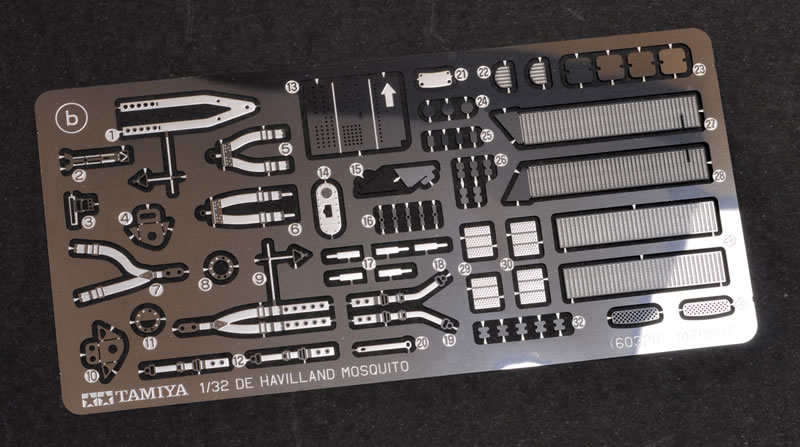
Optional seated pilot and navigator figures are included.
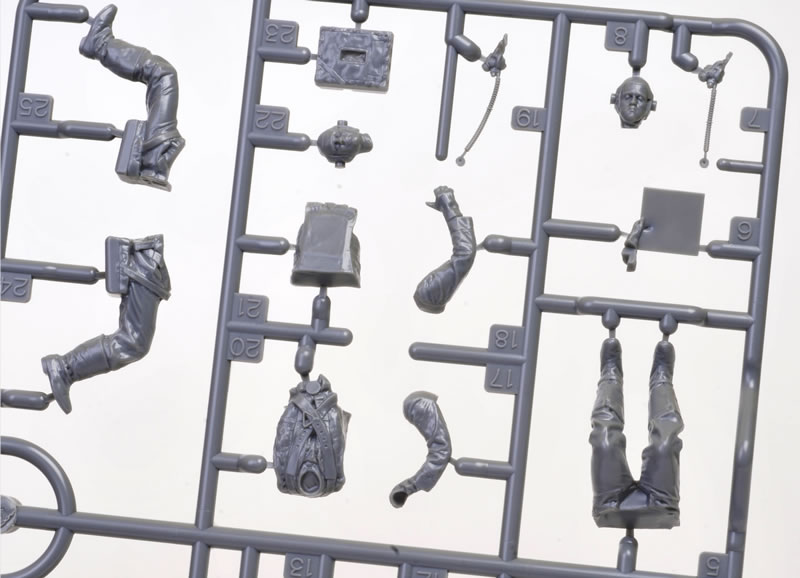
The rest of the cockpit and the sidewalls are packed with boxes, switches, quadrants and cabling.
Tamiya has slightly revised, and in my opinion improved, the design of their instrument panel by using a photo-etched part for the panel face. This is thinner than the plastic parts used in the earlier kits, which in turn means that the clear lens layer is thinner too, which should reduce the "Mr Magoo" magnification effect on the underlying instruments.

As with earlier Tamiya 1/32 scale kits, the instruments are printed in clusters onto the back of decals, so don't worry that you can't see the actual dials when the decals are still on their backing sheet.
The nose gun bay is equally detailed, with four .303 machine guns and their ammo feeds. The fuselage also features central bulkheads and three options for displaying the highly detailed bomb bay - closed, half-open or fully open to reveal the Hispano gun bays and 500 lb bombs.
The elevators may be posed in either the neutral or dropped position. Each pair of landing flaps are connected too, ensuring that they will be posed at the same angle. The ailerons are separate parts that are glued to the wings.
I must say that I don't miss the metal hinges and moveable control surfaces - this is much neater.
Two fully detailed engines are supplied. It appears that the basic block and cylinder heads of the Merlin engines are the same as we have seen in the Spitfire and Mustang kits, but there is a world of difference by the time the unique supercharger, intercooler, oil tank, fittings, plumbing and mounts are installed.
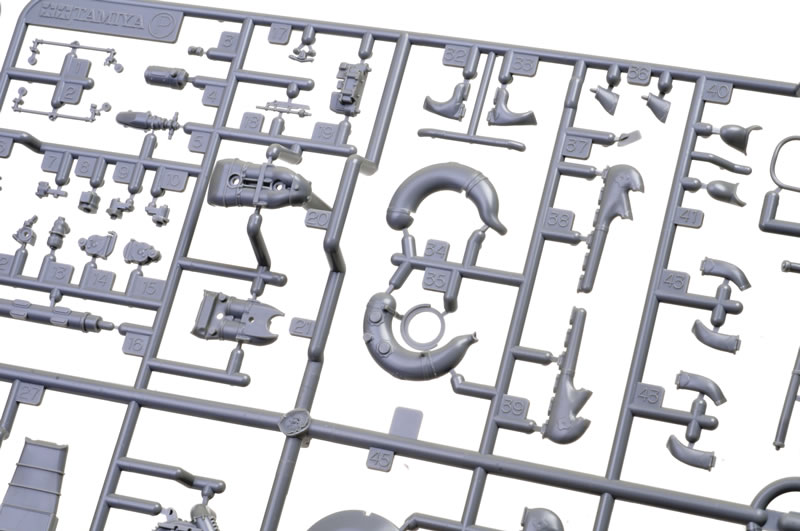
Once again, the Merlin engines are beautifully detailed assemblies and uncompromising in size thanks to the scale-thin cowlings. These are held in place with miniature magnets, and may be removed to display the engine.
Two styles of exhausts are included - exposed five stack and shrouded two stack. For the first time in any Mosquito kit, Tamiya also offers the choice of the standard short carburettor intake on the bottom cowl, or the longer tropical intake.
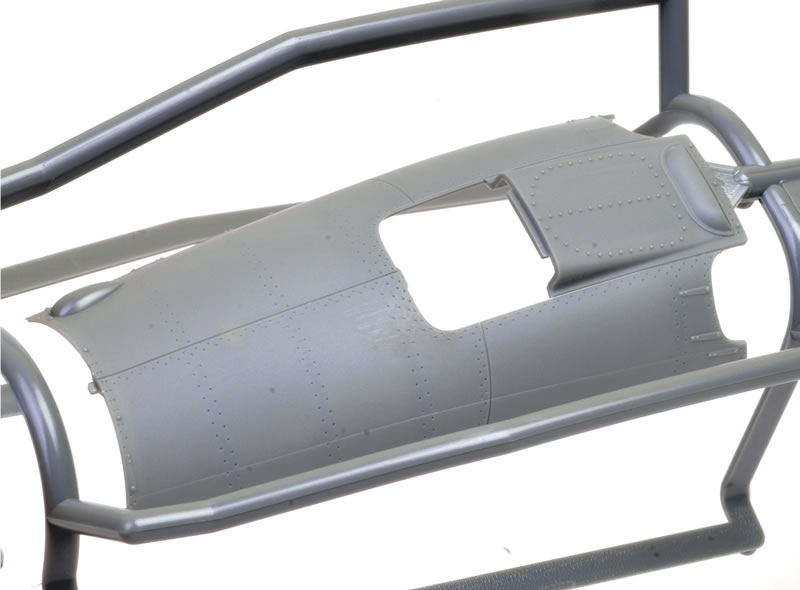

Just like the real Mosquito, the wing, wheel wells and bomb bay are built around a stout wing spar box. To ensure the best possible fit and alignment, the wing spar is actually screwed to the bottom wing halves, creating a rigid, full span wing assembly.
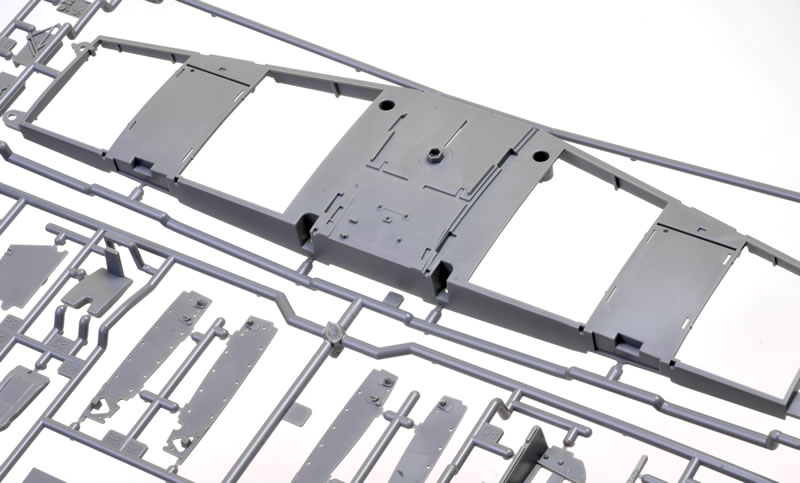
In addition to remarkably detailed wheel wells, Tamiya includes wing fuel tanks.
The undercarriage is fabulous, with the main legs being assembled on a supplied jig. Once complete, the legs slide onto long locating pegs to guarantee a very strong connection and the correct angle. Oleo struts are moulded with compressed fabric covers. Hydraulic lines are supplied as separate parts.
The bulged and flattened main wheels feature characteristic block treads. These are supplied as injection-moulded plastic - no vinyl tyres here. In order to avoid a difficult to eliminate centreline seam, the tyres are cleaverly moulded with interlocking block tread sections. This might be a frightening prospect if it was any other model conpany, but I am confident that the fit will be perfect and the result should be effective.
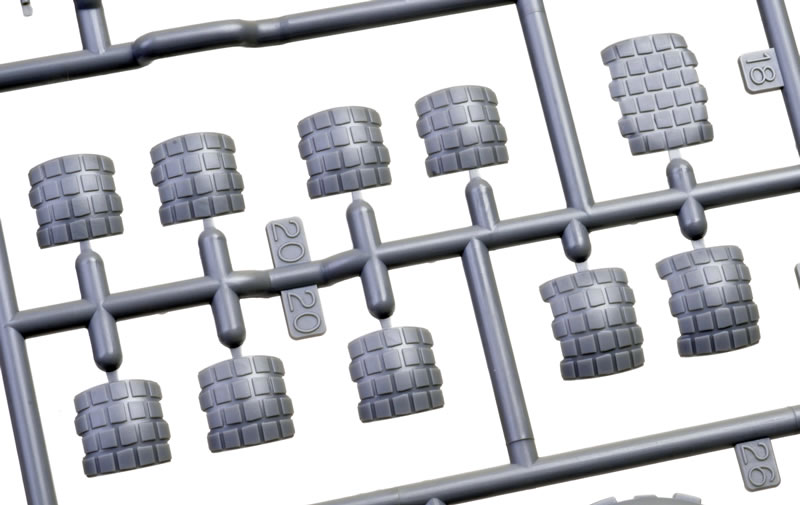
Both needle blade and paddle blade propeller assemblies are supplied, along with two styles of spinner.
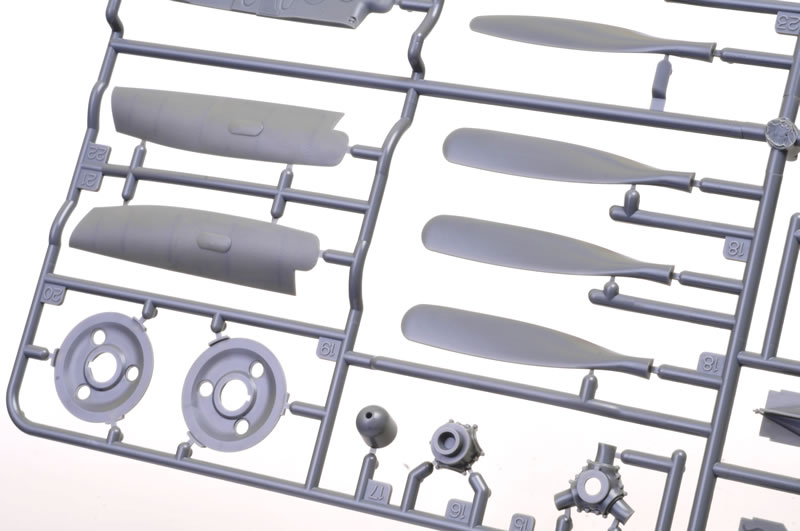
Other options include conformal wing tanks and aerial mast.
The canopy is provided with underlying plastic framework over which the clear part is placed. Separate bulged and flat side window options are offered.
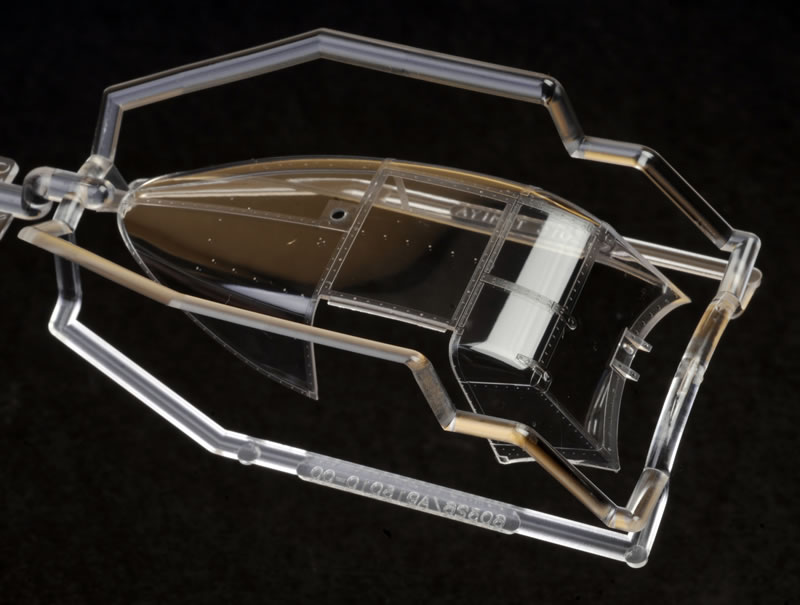
For the initial export release, Tamiya has included a limited edition set set of clear frosted cowlings so that the engines may be glimpsed even if the covers are in place.
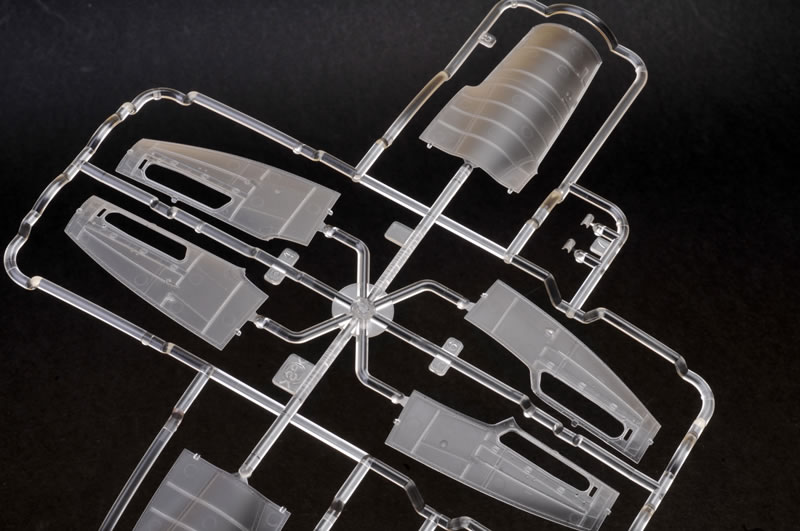
The crew entry door may be posed open or closed, and an optional boarding ladder is included. Tamiya has also included a third aircrew figure climbing the ladder. Detail of the multi-part figures is excellent, with natural facial features and realistic fabric drape.
As usual, Tamiya has included a printed, self-adhesive masking sheet for the external canopy frames. You need to carefully cut these from the sheet yourself.
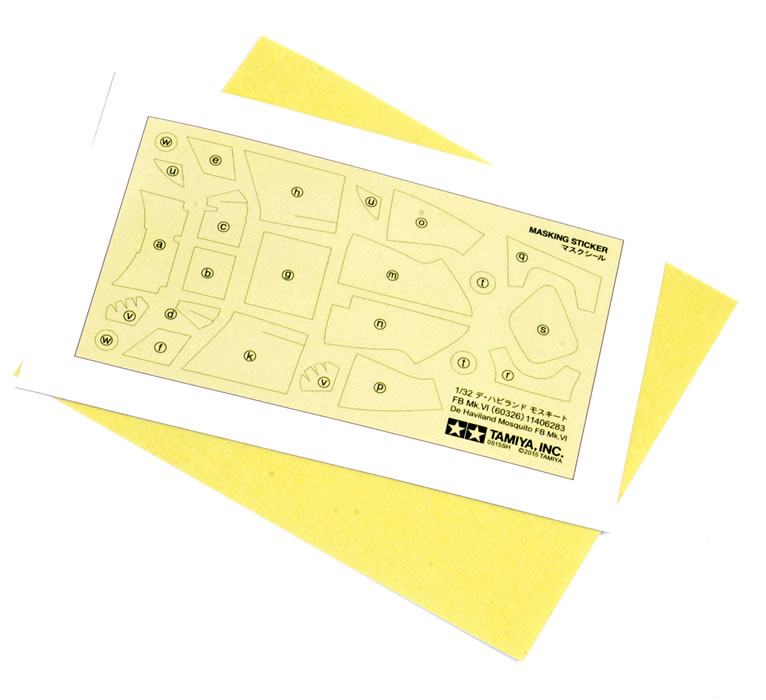
Construction is called out over 105 steps. These are all clearly illustrated and feature additional notes where necessary. Options are clearly marked. A full parts summary and stencil marking guide are also provided.
Markings
Markings are supplied for three aircraft:
-
EG-F, serial HX922 - 487 Squadron RNZAF, Hunsdon UK. This aircraft is finished in overall Medium Sea Grey with disruptive RAF Dark Green on the upper surfaces.
-
SM-A, serial LR303 - 305 (Polish) Squadron RAF, Lasham UK, Spring 1944. This aircraft is finished in overall Medium Sea Grey with disruptive RAF Dark Green on the upper surfaces.
-
NA-Y, serial A52-518 - 1 Squadron RAAF, Labuan, Borneo, August 1945. Finished in overall Silver (paint).
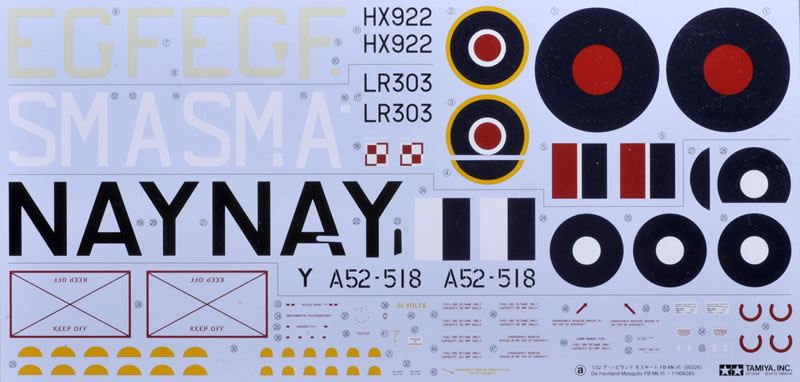
Extensive stencilling is supplied.
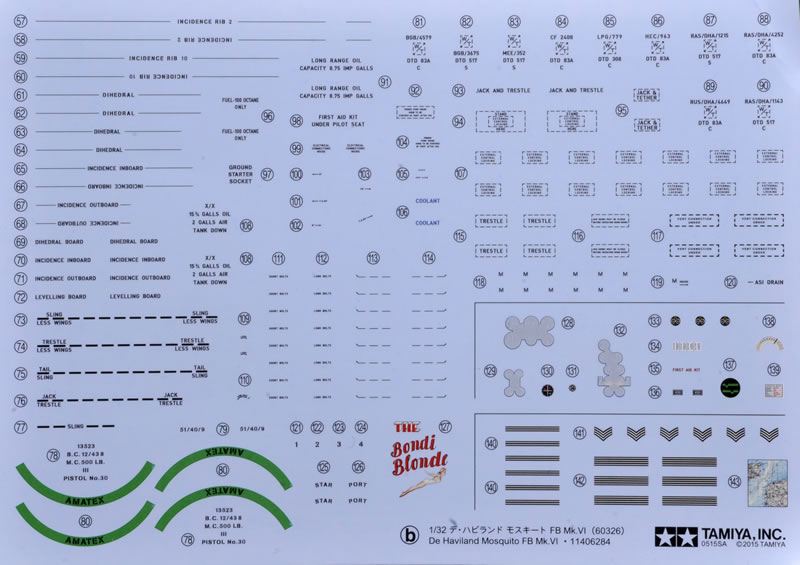
My decal sheets are a pre-production version, but colours and printing look very good.
Tamiya has raised the bar once again.
Rather than rest on their laurels, Tamiya has managed to make incremental improvements this time around, including the photo-etched instrument panel face and the unique arrangement for the complex block tread tyres. Attention to detail is just fantastic too.
This is an outstanding kit. If you have the slightest interest in the Mosquito, Tamiya’s new 1/32 scale kit will be an essential ornament to your modelling shelf.
Thanks to Tamiya for the sample.
Tamiya kits are distributed in the UK by The Hobby Company
Text and Images Copyright © 2015 by Brett Green
* Historical Text Courtesy of Wikipedia
Page Created 3 June, 2015
Last updated
4 June, 2015
Back to HyperScale Main Page |
